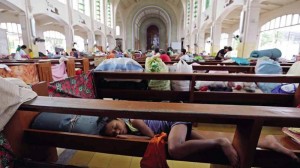By Jeremy Reynalds
DAVAO CITY, PHILIPPINES (ANS) — Typhoon Ruby tore apart homes and sent waves crashing through coastal communities across the eastern Philippines on Sunday, creating more misery for millions following a slew of deadly disasters.
AFP News Agency reported in a story that local weather agency PAGASA said the typhoon roared in from the Pacific Ocean and crashed into remote fishing communities of Samar island on Saturday night with wind gusts of 210 kilometers (130 miles) an hour.
The wind strength made Ruby the most powerful storm to hit the Philippines this year, exceeding a typhoon in July that killed more than 100 people.
“Tin roofs are flying off, trees are falling and there is some flooding,” Stephany Uy-Tan, the mayor of Catbalogan, a major city in Samar, told AFP by phone minutes after Ruby hit land.
Fearing a repeat of last year when Super Typhoon Yolanda claimed more than 7,350 lives, AFP said the government undertook a massive evacuation effort ahead of Ruby that saw millions of people seek shelter.

A child uses a pew as a makeshift bed inside the Redemptorist Church in Tacloban City where residents evacuated ahead of the landfall of Typhoon “Ruby”
Ruby was forecast to take three days to cut across the Philippines, passing over mostly poor central regions, while also bringing heavy rain to the densely populated capital of Manila slightly to the north. The government warned of storm surges up to five meters (16-feet) high in some areas, flash flooding, landslides and winds strong enough to tear apart even sturdy homes.
AFP said tens of millions of people live in the typhoon’s path, including those in the central Philippines who are still struggling to recover from the devastation of Yolanda, which hit 13 months ago.
Yolanda was the strongest storm ever recorded on land, with winds of 315 kilometers an hour, and generated tsunami-like storm surges that devastated entire towns.
As day broke on Sunday, many areas across the eastern Philippines were unreachable and it was impossible to know how badly they were damaged, Red Cross secretary general Gwendolyn Pang told AFP.
In those that were reachable, AFP said residents and officials reported terrifying winds and waves that destroyed homes, although with most people in evacuation centers there were hopes casualties would be few.
In Tacloban, one of the cities worst-hit by Yolanda, palm-thatch temporary houses built by aid agencies for survivors of last year’s typhoon had been torn aport, vice mayor Jerry Yaokasin told AFP. However there was no repeat of the storm surges that did the most damage during Yolanda.
“There is a collective sigh of relief. The initial assessment is that there are no casualties. We were better prepared after Yolanda, up to 50,000 people were packed in evacuation centers,” AFP reported he said.
Yaokasin added, “But the transitional shelters made of nipa (palm thatch) were blown away. Our biggest challenge is how to provide for those who were displaced because of that.”
In the eastern region of Bicol that is due to be hit throughout Sunday and Monday, authorities said they were aiming for 2.5 million people- half the local population-to be in evacuation centers.
AFP said at dawn on Sunday, huge waves pounded the coast of Legazpi, a major city in Bicol that was due to feel Ruby’s full force later in the day. Walls of walls of seawater more than one-meter high crashed above the city’s seawall and sprayed water and debris onto the deserted Legazpi Boulevard, according to an AFP reporter.
The Philippines suffers about 20 major storms a year which, along with regular earthquakes and volcano eruptions, make it one of the world’s most disaster-plagued countries. The storms regularly claim many lives but they are becoming more violent and unpredictable because of climate change, according to the United Nations and many scientists.







